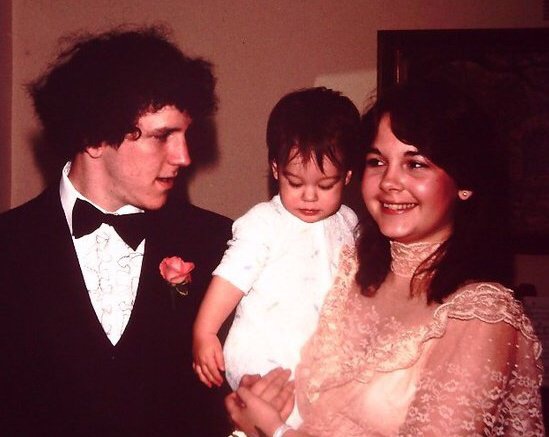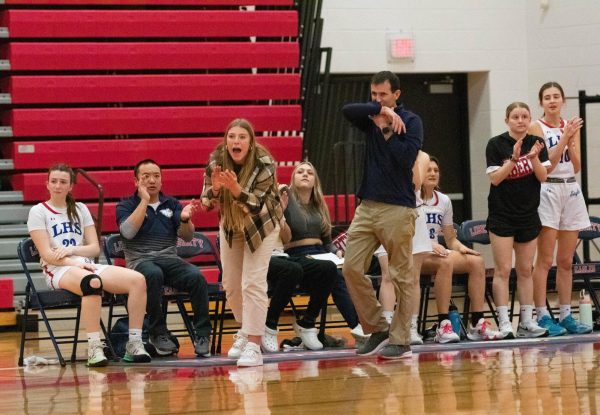Hazelwood: 30 Years Later
An exclusive look back on the controversial Hazelwood v. Kuhlmeier decision from a former member of the publications staff

Jennifer O’Brien stands next to the father of her baby, Gary O’Brien, and holds her daughter Colleen before the couple attends senior prom.
January 10, 2018
The Hazelwood v. Kuhlmeier case has been called one of the most significant events in the history of American journalism. Jennifer O’Brien was at the forefront of the case that has changed free speech for student journalists ever since.
Based in the suburbs outside of St. Louis, the controversy arose after the principal of Hazelwood East High School pulled two pages from the student newspaper, The Spectrum in the fall of 1987. These pages, which contained a total of seven articles, were pulled for only two stories. One was about teen pregnancy and contained interviews from three girls from the high school, but their names were changed to preserve their identities. The other article was a feature story about a student’s experience with having divorced parents; the issue arose because her family had no opportunity to share their perspective or defend their actions.
When the principal removed the articles, the students felt like their freedom of speech had been violated. They had actually just been learning about their First Amendment rights in class, according to O’Brien, a member of The Spectrum publications staff at the time of the incident. This sparked the decision to take the issue to court.
“We were all really shocked. The whole thing was strange because at the part of doing that edition, they were talking about freedom of speech. We were learning about it and then we did this and then we went to get the paper and there was no paper. It was really strange.”
The students first went to the U.S. District Court for the Eastern District of Missouri and were told that their freedom of speech had not been violated. However, the students still believed that it had been, so they took it to the U.S Court of Appeals for the Eighth Circuit where they reversed the decision. Subsequently, the school appealed to the Supreme Court where the final decision was made: a 5-3 vote in favor of the school. Certiorari was granted to overturn the Eighth Circuit’s decision.
The rights of student journalists in public schools have been significantly changed due to this ruling. Now, student journalists are subject to the opinions of their principals concerning what they publish. Principals now have the power to remove articles that they do not see fit for their student body. Some people still believe that this censorship is unfair, one of whom is O’Brien. In fact, O’Brien believed it was just the administration that was judgmental about her motherhood. Furthermore, she still believes that the article she was featured in was appropriate for high school students and could even be beneficial for them.
“These are teenagers,” O’Brien said. “This is part of their life. You can’t cover it up and you should not cover it up.”
Colleen, O’Brien’s daughter that she had as a teen, shares this view.
“[Teen pregnancy and divorce] is something that happens realistically in all high schools… especially divorce. That’s not a controversial topic.”
O’Brien explains that although she does not agree with the court’s decision, she also does not believe that student publications should be totally uncensored. She uses the example of exposing teachers as drug addicts as being a topic that would cross that line, but remains firm in her belief that the teen pregnancy and divorce articles were timely and age appropriate.
However, O’Brien recounted that she heard that the administration told their journalism teacher that he couldn’t do those topics, but he did them anyway and didn’t tell the students. The same day that the students discovered what had happened to their paper, O’Brien says, the journalism teacher seemed to have disappeared.
“We never saw that journalism teacher again… We were just told that he wasn’t coming back.”
Today, O’Brien lives in a rural town in Missouri on hundreds of acres of land. She is a trained phlebotomist and currently works in an office. The 30-year mark of the court case amazes her and serves as a reminder of the limitations that can be placed upon journalists.


















Mary Beth Tinker | Jan 30, 2018 at 7:51 pm
Thanks for a great article about this important case that dealt a blow to the free press and to students’ rights that had been confirmed under the “Tinker” ruling of 1969.
We’ll be on fb tomorrow – Jan. 31st- talking about the case all day, and how we can “Cure Hazelwood” in all 50 states. Students have already succeeded in expanding their press rights in 13 states, and now it’s on to the others, including Missouri this year! Check it out at Student Press Law Center http://www.splc.org/page/hazelwood-day-of-action and you can help to #CureHazelwood, too! Mary Beth